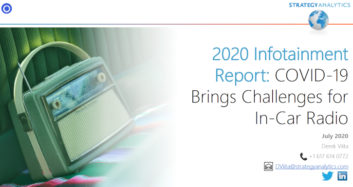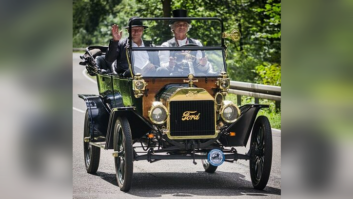 The pandemic has had a sizable impact on AM/FM car radio listening habits, according to a new survey by Strategy Analytics — including finding that the pandemic has led to a decline in AM/FM usage in-car and a steep decline in interest of radio as a must-have feature.
The pandemic has had a sizable impact on AM/FM car radio listening habits, according to a new survey by Strategy Analytics — including finding that the pandemic has led to a decline in AM/FM usage in-car and a steep decline in interest of radio as a must-have feature.
A new report from market researcher Strategy Analytics called “2020 Infotainment Report: COVID-19 Brings Challenges for In-Car Radio,” which surveyed 4,705 car owners across the U.S., China, France, Germany and Italy to investigate usage of in-car infotainment including AM/FM radio, streaming media and other sources.
[Read: Radio Listening Audiences Rebound Despite Pandemic Impact]
According to the report’s author Derek Viita, who is a senior analyst with Strategy Analytics, 2020 is the year that in-car AM/FM radio has hit the proverbial iceberg. Year over year, interest in radio has steadily declined relative to other sources like streaming or brought-in digital media, the survey found.
“While radio still has unique advantages, the pandemic has only worked to increase adoption of other media sources,” Viita said. “Some radio providers in the West are reporting that their ratings have nose-dived because many of those who listened on their commute have not rejoined from home.”
These findings somewhat contradict other surveys conducted earlier this year. Two separate Nielsen surveys found that radio listenership had rebounded after the initial stages of the pandemic and that despite the pandemic, radio listenership remained strong.
But what is clear about car radio listening is that after years of dominance, traditional radio has reached a turning point as streaming media continues its march onto the dashboard, Viita said. In addition, the survey revealed that the COVID-19 pandemic and its related lockdowns severely curtailed regular commuting journeys, where much of consumers’ radio-listening originates.
This has led to a marked decline in AM/FM usage in-car, and a steep decline in interest of radio as a must-have feature, the survey found. This year’s decrease was surprisingly sharp in certain Western markets, he said, where commuting and other regular shorter-distance trips have been curtailed.
“With these regular trips curtailed, are folks just ‘not missing’ their car radio?” Viita asked. “[It] remains to be seen whether this is a one-year aberration or the start of an accelerated trend.”
[Read: Amidst Stay-at-Home Orders, Radio Listenership Remains Strong]
Diving deeper into an executive summary of the report, the survey found that streaming media has had a steady year-over-year increase both in terms of daily/weekly usage. That surge has happened more quickly in China with streaming ranking number one over AM/FM radio for usage and interest among car owners.
Looking ahead, the post-pandemic future of radio is unchartered territory. As systems like Android Automotive embed media apps as standard, this will put additional pressure on radio, said Kevin Nolan, vice president of the UX Innovation Practice, a segment of Strategy Analytics.
“Provided that these systems allow quick and easy login, [heaving] direct access to streamed content without having to deal with Bluetooth or device cables will result in further adoption and consumption,” he said. “Broadcasters, product planners and UI designers must immediately reconsider how, when and why listeners consume entertainment and information and across which platforms.”
The report suggested that designers and product planners should consider a number of key issues over the coming months. What are some new ways that broadcasters can reach car owners during the pandemic? Are there unmet needs for satellite radio users or integrated screen users — like users of Apple Car Play — that broadcasting should consider? As the next-generation of automated systems come online, which infotainment sources will become more desirable and which will fade away?
What broadcasters need to do, Viita suggested, is to think about new ways to reach viewers during and after this pandemic environment.
“Clearly a large chunk of listeners — commuters who might listen to a certain program going to or from an office — have not rejoined from home,” Viita said. “Broadcasters need to find new ways to reach car owners during the pandemic, to ensure they’ll rejoin after it.”
Viita explained the discrepancy between the findings here and other surveys by clarifying that the Strategy Analytics survey only speaks to car-specific radio usage/interest. “In the car: radio’s not going anywhere,” Viita said. “Despite these year-over-year declines in usage and interest, it’s still number one in the car in the West (and top two in China).”
Radio has power: In a separate consumer survey, Strategy Analytics found that radio remains important for certain activities, such as work commutes. “It’s convenient: no need for a separate device [or] cord to connect a device; no need to spend time to actively choose a specific song or artist; no need to think about whether the commute would be long enough to hear all the content (e.g. an entire podcast),” Viita said. “It’s also utilitarian — it has all the information they need, they feel productive by catching up on news/current affairs, they can learn what’s trending, etc.”
For better or worse, two things are true when it comes to in-car audio trends, Viita said. One, a widening segment is adopting streaming media as their primary source in the car. On the other hand, radio remains tailor-made for the car, especially commutes, he said.







